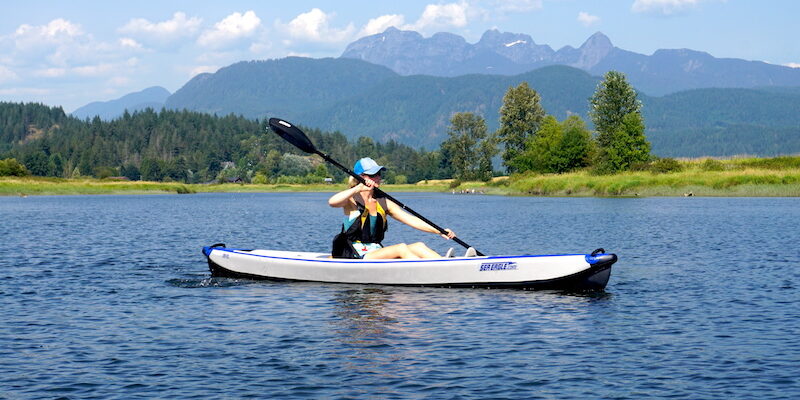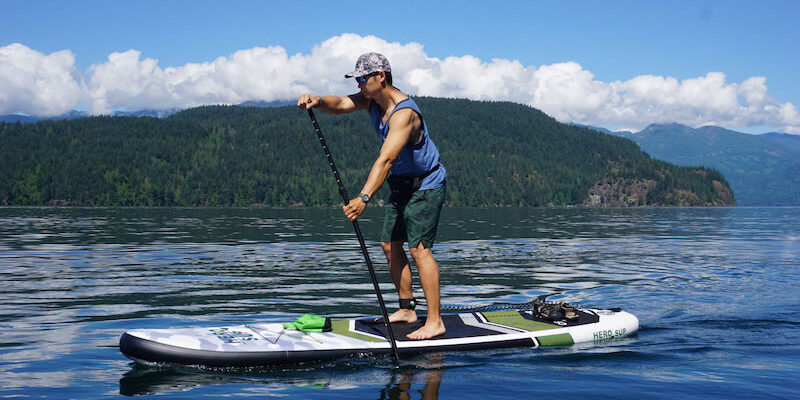How well you take care of your inflatable can directly affect how long it lasts. Wear and tear are normal and they are made to withstand a fair amount of use and abuse.
However after over a decade of paddling inflatable kayaks I have learned there are things you can do to prolong the life and durability of your purchase.
For one proper care is essential. I know many people who finish paddling, get their kayak out of the water and simply roll it up wet and store it away. That is a recipe for disaster.
Follow these steps to protect your inflatable kayak so you can enjoy it for as long as possible.
1. CLEAN
Clean any sand or dirt out of the valves. Clean the rest of the kayak with warm water and mild natural soap every once in awhile.
Things like oil from your skin and sunscreen build up over time as they transfer from you to the kayak.
I also normally give my kayak a good scrub once a year to remove any marks that have built up.
2. RINSE
Always rinse the kayak off with fresh water after use when sea kayaking.
Salt water will corrode the material and although not rinsing it once or twice is not that big of a deal, over time it can do real damage.
Close all of the valves before rinsing to make sure no water gets inside the air tubes. The last thing you want is mold or mildew growing inside of your kayak.
Rinsing will also help clear any dirt or debris off the material as well as prevent damage from chemicals in the water.
You might be surprised to learn how many agricultural and industrial chemicals run off into rivers.
Any body of water where there are speed boats will likely contain diesel, oil and fuel as well.
All of these chemicals can eat away at the material of your kayak unless you rinse it after use.
3. DRY
Drying the kayak properly not only protects the material but also eliminates the growth of mold and mildew.
There’s nothing worse than being excited to take your kayak out for the first time of the season only to find out it’s a little greener than it was before!
Mold and mildew will degrade the material making it more susceptible to leaks and punctures.
Bring an old towel along and use that to dry the kayak well after use.
The floor is removable so you can easily dump any water out and dry properly.
I would not recommend leaving the kayak out in the sun for an extended period of time to dry as heat and direct exposure to sunlight can do its own damage, which brings us to the next point.
4. UV PROTECTION
You can use a 303 Protectant spray to protect the PVC material from harsh UV rays. 303 Protectant is easy to use and works great. Follow the instructions on the bottle for best results.
5. AIR EXPANSION
Heat will cause air pressure to expand. So if you are out in the hot sun for several hours you might want to let a little air out of the kayak to allow for air expansion, which also helps protect the seams.
The kayak tends to get hotter when it is sitting out of the water, especially on pavement. It tends to stay cooler while actually in the water so be especially careful leaving your kayak docked somewhere exposed to the hot sun.
6. AIR PRESSURE
Follow the air pressure guidelines that come with your inflatable kayak. Over inflating your kayak will damage the seams.
Most inflatable kayaks can be inflated anywhere from 2.5 – 3.5 PSI.
Although there are some that can hold a lot more and a few that have high pressure floors (such as the Sea Eagle kayaks) that hold up to 10 PSI of air pressure.
So be sure to check your owners manual and follow the guidelines correctly.
7. FOLDING THE KAYAK
When you fold/roll your kayak up to store it away there are a few things to keep in mind.
If you roll it the exact same way each time you will crease the same area over and over possibly weakening that area.
Try and fold it up loosely and in a slightly different fashion each time.
I know this can be tricky as most of use are just trying to roll it up small enough to fit inside the storage bag.
However if you can keep it a looser roll and not crease the same area each time you will eliminate unnecessary weak points.
8. STORAGE
Storing an inflatable kayak is so much easier than storing a rigid kayak. You don’t need a lot of space but you do need a dry cool place to keep it.
It’s best not to leave it inflated while storing away for an extended period of time.
Leaving it inflated can cause stress on the seams and valves especially if the temperatures rise and the air expands.
EXTRA CARE = LESS WORRY
Inflatable kayaks are extremely convenient when you don’t have the space to store or transport a rigid kayak. They are easy to set up and ideal for storing in small spaces.
Many come in a portable backpack so you can take them anywhere.
I have paddled inflatable kayaks for a long time now and absolutely love using them. They make it easy to get out and enjoy being on the water exploring new areas.
I have found that by following the above tips my inflatable kayaks have lasted a very long time and had very few issues.
Although there may not be time every single outing to follow each step to a tee, if you can follow these guidelines the majority of the time it will make a big difference in the lifespan of your purchase.
Give your inflatable kayak a little extra TLC so you can enjoy everything it has to offer and not worry about annoying leaks.
Got more questions? For everything you need to know about inflatable kayaks see our Ultimate Guide To Inflatable Kayaks where we try to answer as many of the most popular FAQ as possible.


This is great information, thank you. My question is regards to heat/ temperature. We take good care of our inflatable kayaks as direct above and have them inside a durable storage container, although recently we moved them into our backyard storage shed. We are not sure yet what the temperature will be inside there as we have not gotten into our summer weather.
Any thoughts about temperature of storage location?
Hi Lydia, I’m not sure how hot or cold it gets where you live but basically as long as it’s not exposed to the elements it should be okay. You just don’t want direct sunlight shining on it if possible.
I have a couple inflatable Kayaks, and I find it hard to take care of, and get bag in a bag on the beach. I am looking for more of a hard box , i could do a quick fold up, drop it in, and then at home, wash it, dry it, and store it in there bags. Any suggestions, I am having trouble finding something that’s not the size of a small truck bed.
I have no storage space problem but interested in inflate kayak (Aquaglide Chelan 140 maybe) as they are light to carry with one person – loading/unloading on car roof rack also.
Any other recreational kayak type do you recommend in case of light weight?
Hi Kasra, The Aquaglide Chelan 140 is a good kayak. A few other lightweight options would be the Sea Eagle FastTrack – same weight as the Chelan at 35 lbs. – I’ve used this one a lot and always enjoyed it. Or the Aquaglide McKenzie 125, which is actually 5 lbs. lighter than those two at 30 lbs. The Sea Eagle 300X is also 30 lbs. and a good kayak. Or cheaper options would be the Sea Eagle 330 which weighs 26 lbs. or the Intex Challenger K1, which only weighs 27 lbs. All of these are easy to transport. Hope this helps, any other questions just let me know!
Hi! Thanks for all your helpful info. I bought an Intex Challenger 3 Inflatable boat back in in 2004 and have used the heck out of it for fishing small lakes in Northern Idaho and Northwest Montana. Never once got a hole in it until a few summers back when a small catfish I was releasing decided to be a jerk and stab my boat as it swam off!
I have always loved the workout of paddling so have never had a motor on her, but after a two hour fight to return to shore (with 300 lbs of helpless pssengers) during a sudden wind storm, and a surgery to repair my torn rotator cuff, I have decided it’s time for a motor for the boat and an inflatable kayak for when I am going solo. I prefer the sit on top style kayaks though. Are there any brands you recommend for holding someone weighing 230 lbs plus a bit of fishing gear?
Wow it sounds like you’ve had some crazy adventures! The inflatable kayak that first comes to mind for your needs is the Sea Eagle 385FTA – the Pro Motor Fishing Rig Package. It is absolutely awesome and comes with a swivel seat that keeps you sitting up high as well as a motor mount and an electric motor. It’s fully decked out and reinforced for fishing plus can hold a ton of weight (up to 635 lbs.). You can see my review for it here.
Storing inflatable kayaks – I am concerned about my Intex kayaks. I did clean and dry them, I rolled them up and put a bungee cord around. BUT I think there could be some creases.
Would it be better to just unroll them again and store flat??
thanks!
It’s hard to avoid creases but as a general rule I try and role my kayaks loosely instead of too tight. I wouldn’t worry too much about it, mine are always stored rolled up.. but if you have the space to roll it out flat then yes totally go for it.
Thank you for the great informations regarding inflatable kayaks! What do you think of storing the inflatable kayaks/pedalboards slightly inflated/deflated so that there is no stress on the seams and valves (of course provided we have space to do so). I guess the reason for this is that we do not want the creases to be sitting there for too long. Thanks!
Should be just fine to store them that way as long as they are kept out of the elements.
Last year we moved to St Augustine. We had purchased 2 kayaks from you only to find the area is surrounded by oyster beds. Do you have a resale option?
Hi, Sorry to hear about the oyster beds, that’s really unfortunate. We don’t actually sell the kayaks here we simply review them. I can try and point you in the right direction though, which kayak did you buy?